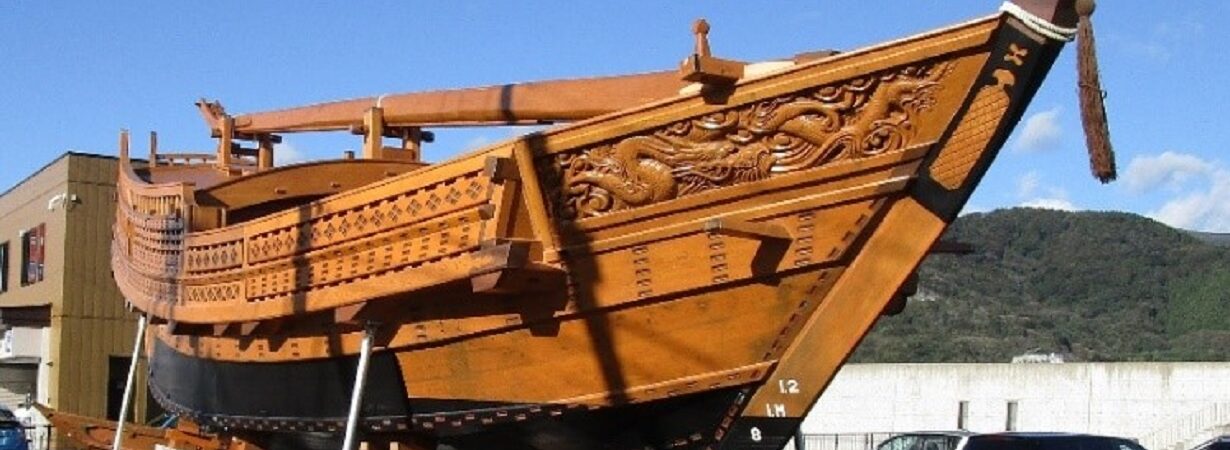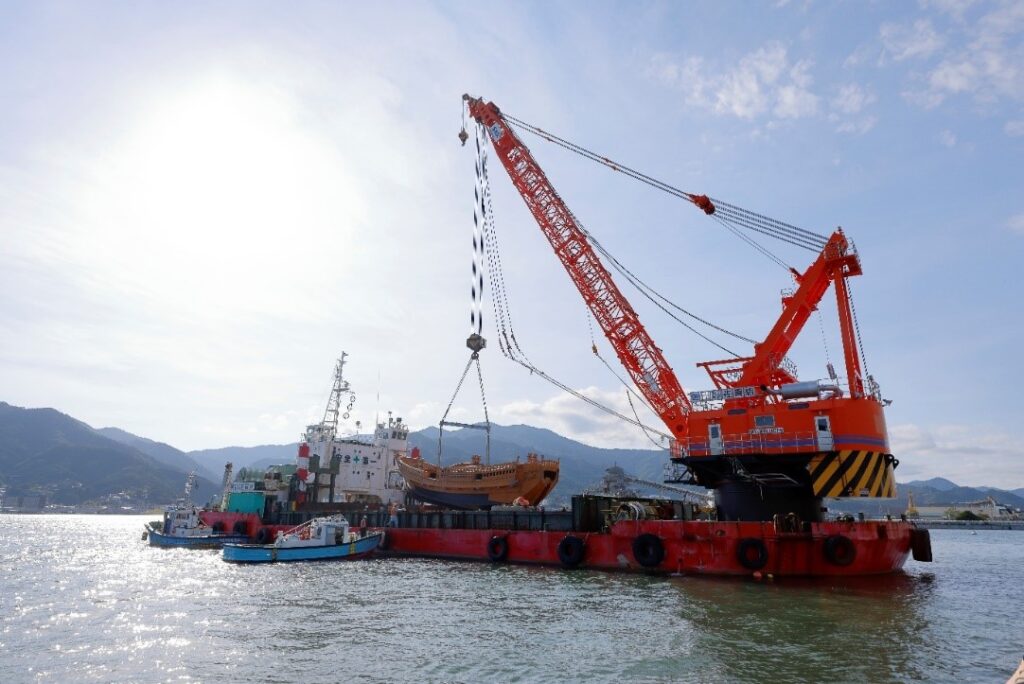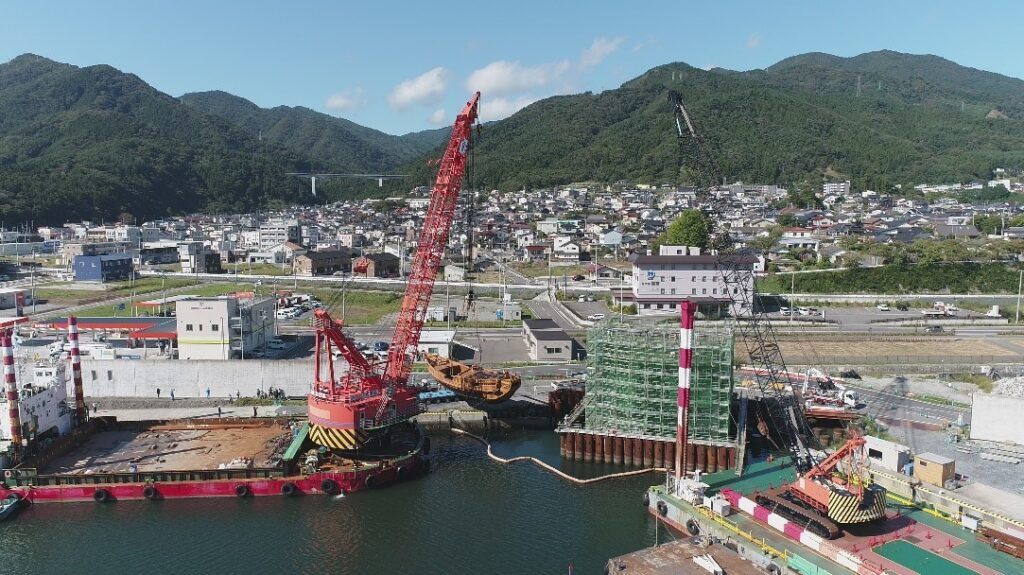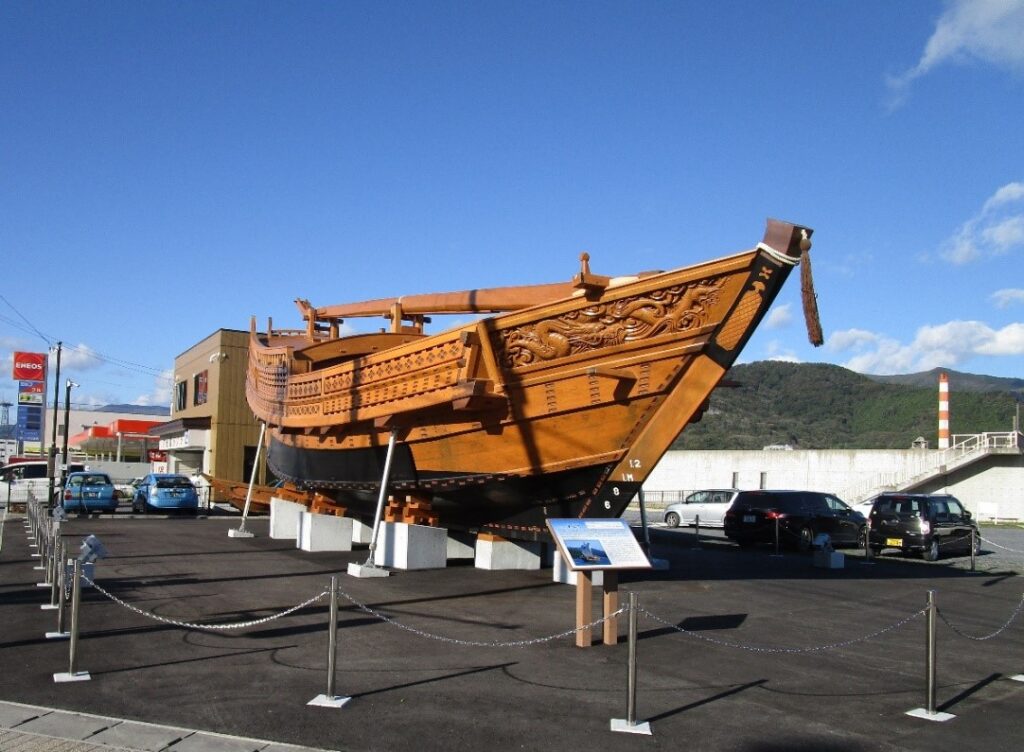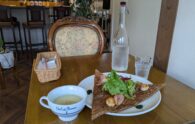On October of 2021, Ofunato City had started the on-shore displaying of the Sengoku Ship “Kesenmaru” which overcame the Great East Japan Earthquake and Tsunami. For today’s article I would like to introduce you all the ship which has become the new symbol of recovery for Ofunato.
What is a Sengoku Ship?
A Sengoku Ship (written using the Kanji characters which symbolize ‘thousand koku ship’), is a large-scale wooden sailing ship which had largely contributed to the development of Japan during the Edo-Period (1603-1868). The ‘Sengoku’ points to the fact that this ship can carry a thousand ‘koku’ or bags of rice. (Note, one koku is approx. 150kg and is the amount one adult will consume in a year.)”
Reproduction of the Sengoku Ship “Kesenmaru”
From long ago, the Southern Coastline of Iwate, generally known as the Kesen Area (the area includes Ofunato City, Rikuzentakata City, and Sumita Town) had been known to be flourishing in the fishing industry thanks to the Sanriku Fishing Spot where the cold and warm current collide. As such, the Kesen area’s ship building skills were very strong and the high-quality lumber (Kesen Cedar, Goyo Hinoki (famous Cypress Lumber of the area), Japanese Red Pine, Japanese Keyaki (Zolkova), etc.) available in the area made for a very competitive environment, leading to an even further enhancement of their ship building techniques and skills.
Unfortunately, as time passed the need for wooden ship building largely diminished. But the Kesen Ship Building Association, which is said to be the only ship building group in Japan, had challenged themselves to reproduce the Sengoku Ship using the knowledge and skills passed down from their ancestors. The formal name of the reproduction team which managed the construction was called ‘Kesenbune Shokai’ and after numerous days of hard work, on December of 1991, Kesenmaru was completed.
Half a year after its completion, Kesenmaru is showcased in the “Sanriku Sea Exhibition Event” in Kamaishi City, during which, is nominated as for the Japan Expo Awards. The Kesenmaru had been recognized for its beautiful curvature of the stern, in addition to the traditional techniques incorporated into assembling the parts and the artistic carvings found throughout the ship.
It should be noted that Kesenmaru was used in many other situations such as the Summer Festivals of the city as well as NHK’s Taiga Drama Series ‘Na no Hana no Oki’ and ‘Ryomaden’. (*Taiga Drama is Japan’s famous TV series featuring historical events and people aired on NHK, which is one of the major broadcast stations in Japan.)
Kesenmaru Mooring at the Fishing Harbor
Wooden Carving of the Phoenix at the Stern
Wooden Carving the Dragon at the bow
Details of the Kesenmaru
・Loadable Koku Amount: 350 Koku – Length: 18.70m – Width: 5.75m
・Depth: 1.70m – Height: 5.00m – Mast: 17.00m
・Sail Size: 85 Tatami (1 Tatami = 1.65m2 ) – Total Construction Cost: 70.0mil yen
The Miracle Ship
On March 11th, 2011 (Fri) at 02:46pm, an earthquake of magnitude 9.0 and epicenter at the Sanriku Sea shook the Japan.
The Kensenmaru at the time had been mooring at the Tako-no-Ura Fishing Harbor in Akasaki Town of Ofunato City where Tsunami waves reaching over 7.0m were crashing down. Akasaki Town, many towns on the coast lines as well as Kensenmaru itself were hit with numerous of waves during this day. Although many were hit with devastating damages, even as a wooden ship, Kesenmaru had withstood the Tsunami waves and somehow escaped crucial damages, hereafter being called the ‘Miracle Ship’
The picture below shows Kesenmaru being left within harbor during the drawback of the Tsunami on 3/11/2011. (Indicated with the Red Circle)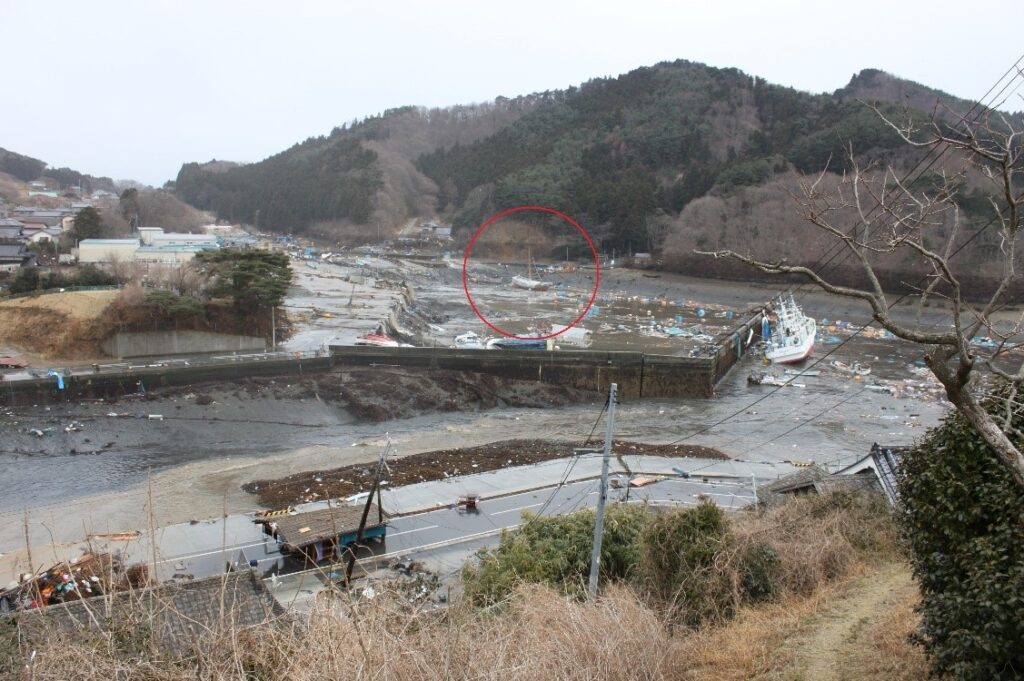
Drawback of a Tsunami Exposing the Ocean Floor of Tako-no-Ura Fishing Harbor (Picture Provided by: Mr. Toshihiro Mori)
2 Days After the Earthquake, Kesenmaru Surrounded by Wreckage and Debris (Picture Provided by: Mr. Toshihiro Mori)
Damage Summary of Akasaki Town
– Death: 52 people – Missing: 6 people
– Full Destruction: 540 homes – Large Scale Partial Destruction: 86 homes
– Partial Destruction: 108 homes – Partial Damage: 183 homes
The Beginning of the On-Shore Display
Although this ship had been loved by many from the day it was built, the damages and rotting of different parts had become eminent after the 30 years in addition to withstanding the Tsunami. As such, the decision to begin Kesenmaru’s reinforcement and repairment construction was set forth as of August 2020.
One year after the repair, in September 2021, the newly reinforced Kesenmaru had once again been put up for display, only this time situated in the ‘Business and Trading Facility Area’ (AKA. Kyassen Ofunato) as one of the new ‘Face’ of the area. It is believed that Kesenmaru will shoulder and pass down the knowledge and traditions of the Kesen shipbuilders going forward.
Kesenmaru Being Transported by Sea
Kesenmaru Being Hung by Crane
The On-Shore Display of Kesenmaru
The View of Kesenmaru from the Observation Deck of the ‘Disaster Prevention, Tourism and Exchange Center’ (AKA. Ofunaport)
Please be sure to stop by the Sengoku Ship ‘Kesenmaru’ when you come visit Ofunato. We will be looking forward to seeing you!
Japanese
【大船渡の新たな復興のシンボル「気仙丸」】東日本大震災の津波を乗り越えた千石船「気仙丸」の陸揚げ展示が2021年10月から始まりました。
そんな大船渡市の新たな復興のシンボルについて紹介したいと思います。
千石船とは
千石船とは、江戸時代に活躍した日本の木造の巨大帆船で、米1000石を積むことができる大型荷船のことをいいます。
※ 米1石の重さはおよそ150㎏で、成人1人が1年間に消費する量。
復元された千石船「気仙丸」
岩手県沿岸南部の気仙地域(大船渡市、陸前高田市、住田町)は、寒流と暖流がまじり合う三陸漁場に位置し、古くから漁労を中心とした生活が営まれてきました。そのため、もともと造船の技術が高く、また、気仙杉や五葉檜(ひのき)と呼ばれる地域の名木、赤松、欅(けやき)などの良材にも恵まれ、船大工の出稼ぎとあいまって造船技術も各地から導入され、工夫が凝らされてきました。
「気仙丸」は、この造船技術を生かして、日本唯一の船大工集団である気仙船大工衆が技術の粋を集めて建てた千石船の復元船です。制作は「気仙船匠会」が担当し、1991年12月に完成しました。
完成の半年後には、釜石市で開催された「三陸・海の博覧会」に出展し、舟尾の曲線美、舟体の木組みや木彫りなど、伝統の技が評価され、「ジャパンエキスポ大賞」に選ばれています。
その後は、市の夏祭りに利用されたほか、NHKの大河ドラマ「菜の花の沖」「龍馬伝」のロケにも利用されるなど、多目的に活躍しました。
[写真1] 漁港で係留されていた気仙丸
[写真2] 船尾右舷に施された鳳凰の彫刻
[写真3] 船主付近に施された龍の彫刻
[気仙丸の概要]
○積石数 350石積み ○船の長さ 18.70m ○船の幅 5.75m
○船の深さ 1.70m ○船の高さ 5.00m ○帆柱 17.00m
○帆の広さ 畳85枚分(畳1枚 1.65㎡) ○総工費 7000万円
奇跡の船
2011年3月11日(金)14時46分、三陸沖を震源とするマグニチュード9.0の地震が発生し、気仙丸が係留してあった大船渡市赤崎町の蛸ノ浦漁港においても、高さ7.0mを超える巨大な津波が押し寄せました。
気仙丸も津波に襲われましたが、木造船でありながらも津波に耐え、大規模な損壊を免れたことから、「奇跡の船」として知られています。
次の写真は引き波の様子を捉えたものですが、漁港に取り残される気仙丸の様子が確認できます(赤丸部分)。
[写真4]海底が見えるほど水が引いた蛸ノ浦漁港(提供:森 利弘 様)
[写真5]震災発生から2日後、瓦礫に囲まれる気仙丸(提供:森 利弘 様)
[赤崎町の被害状況]
○死者 52人 〇行方不明者 6人
〇全壊 540世帯 〇大規模半壊 86世帯
〇半壊 108世帯 〇一部損壊 183世帯
陸揚げ展示の開始
建造から約30年人々に愛されてきた気仙丸ですが、腐食して船体の傷みが激しくなったため、海での役目を終え、2020年8月から修復・補強工事が施されました。
その後1年を経て、2021年9月に、震災後に整備された商業施設「キャッセン大船渡」近くに設置されました。
今後は市街地の新たな「顔」として、気仙大工の技術や歴史の継承を担っていくことでしょう。
[写真6]海上を輸送される様子
[写真7]クレーンにつるされ宙を舞う気仙丸
[写真8]お披露目された陸揚げ展示
[写真9]防災観光交流センター(通称:おおふなぽーと)の展望デッキからも見ることができる
大船渡を訪れることがありましたら、ぜひ「気仙丸」を見にきてください。
皆様がいらっしゃるのをお待ちしています。
